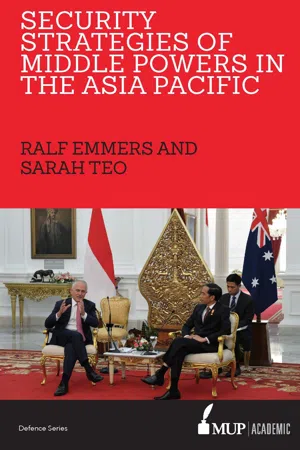
- English
- ePUB (mobile friendly)
- Available on iOS & Android
Security Strategies of Middle Powers in the Asia Pacific
About this book
Security Strategies of Middle Powers in the Asia Pacific examines what drives the different regional security strategies of four middle powers in the Asia Pacific: Australia, Indonesia, South Korea and Malaysia. Drawing on the extant middle power literature, the authors argue that the regional security strategies of middle powers could take two forms, namely, functional or normative. A functional strategy means that the middle power targets its resources to address a specific problem that it has a high level of interest in, while a normative strategy refers to a focus on promoting general behavioural standards and confidence building at the multilateral level. This book argues that whether a middle power ultimately employs a more functional or normative regional security strategy depends on its resource availability and strategic environment.
Frequently asked questions
- Essential is ideal for learners and professionals who enjoy exploring a wide range of subjects. Access the Essential Library with 800,000+ trusted titles and best-sellers across business, personal growth, and the humanities. Includes unlimited reading time and Standard Read Aloud voice.
- Complete: Perfect for advanced learners and researchers needing full, unrestricted access. Unlock 1.4M+ books across hundreds of subjects, including academic and specialized titles. The Complete Plan also includes advanced features like Premium Read Aloud and Research Assistant.
Please note we cannot support devices running on iOS 13 and Android 7 or earlier. Learn more about using the app.
Information
Table of contents
- Cover
- Title
- Copyright
- Contents
- List Of Acronyms
- Acknowledgements
- Introduction
- 1 Conceptualising Middle Powers And Their Security Strategies
- 2 Indonesia’s Middle Power Security Strategy
- 3 South Korea’s Middle Power Security Strategy
- 4 Australia’s Middle Power Security Strategy
- 5 Malaysia As An Incomplete Middle Power
- Conclusion
- Appendix
- Index